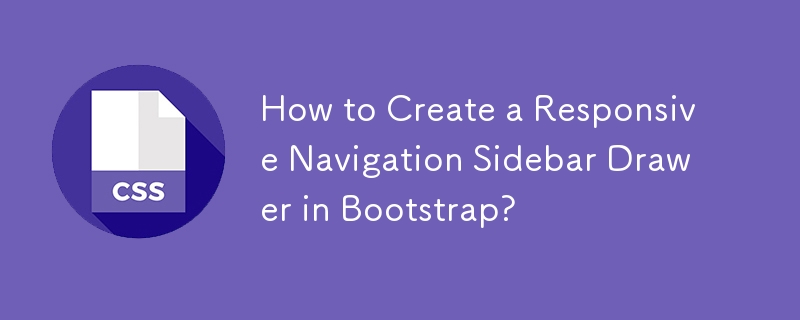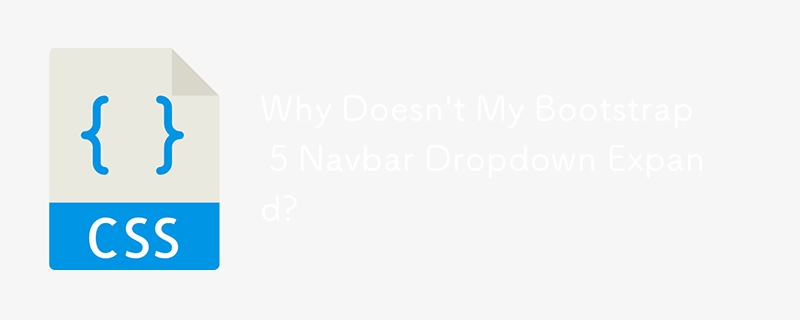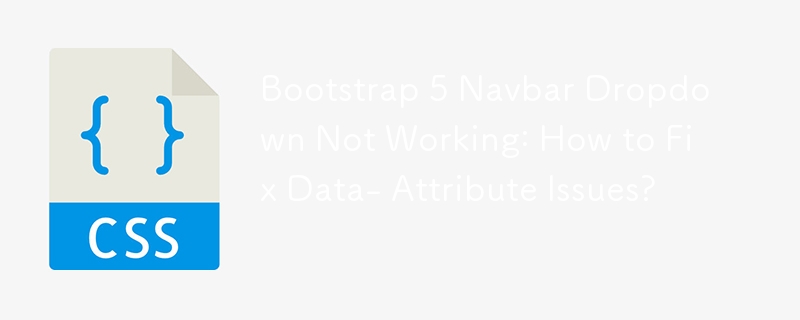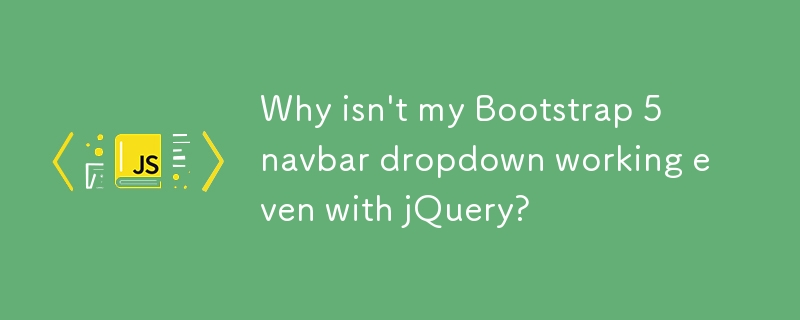Found a total of 10000 related content

Bootstrap Navbar Tutorial: Build a Responsive Navigation Menu
Article Introduction:Building a responsive navigation menu with Bootstrap can be achieved through the following steps: 1. Using basic settings, create a navbar with adjustable layout using Bootstrap's flexible grid system. 2. Make navbar more diverse through custom options such as changing colors, adding drop-down menus, integrating search forms, etc. 3. Pay attention to avoid common errors, such as incorrect use of collapse function and ignoring accessibility. 4. Optimize performance, consider using CDN and loading only the required components. 5. Follow best practices and keep navbar concise and consistent with website design. Navbar using Bootstrap can be quickly prototyped and iterated based on user feedback, thereby improving the website's ability
2025-06-27
comment 0
607
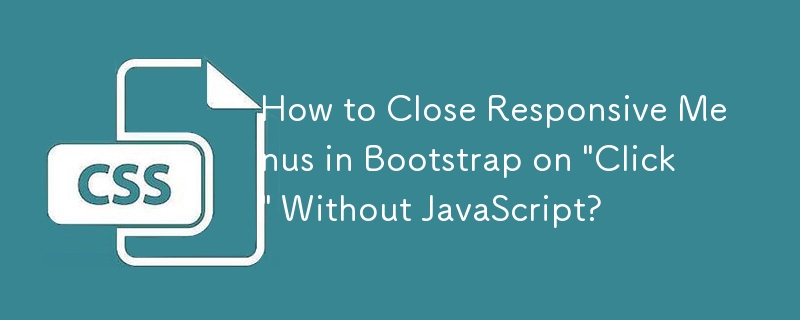
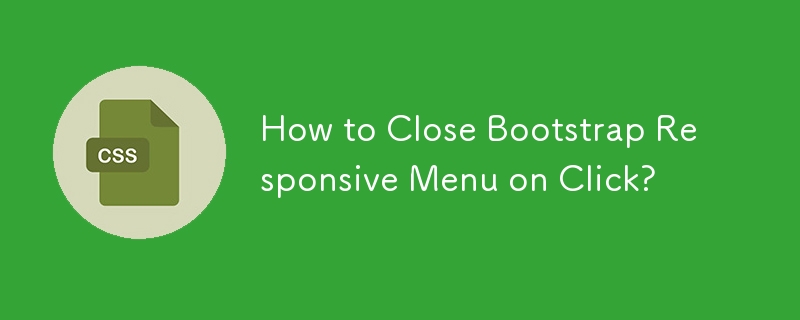
How to Close Bootstrap Responsive Menu on Click?
Article Introduction:Close Bootstrap Responsive Menu on ClickWhen viewing a website on mobile devices, the use of a navigation menu can often be cumbersome. To enhance...
2024-11-08
comment 0
1204


Building Responsive Navigation with Bootstrap: A Complete Guide
Article Introduction:The reason for building navigation using Bootstrap is that it provides a powerful, mobile-first design approach. 1) Bootstrap's mesh system and pre-built components make creating responsive layouts efficient. 2) Its huge community and detailed documentation provide strong support. 3) Use Bootstrap to quickly prototype the responsive navigation bar. 4) By adding the fixed-top class and adjusting the page fill, the problem of blocking content on the top navigation bar can be solved. 5) The drop-down menu in the navigation bar can effectively organize navigation projects and improve user experience. 6) Use CDN to optimize Bootstrap file loading to improve performance. 7) Ensure accessibility of the navigation bar and enhance disability by using ARIA attributes
2025-06-17
comment 0
276

How to Create a Navigation Bar in Bootstrap: A Comprehensive Guide
Article Introduction:The steps to create a navigation bar using Bootstrap include: 1. Create an initial navigation bar using the basic navbar component. 2. Customize styles through Bootstrap's utility class and custom CSS. 3. Ensure the navigation bar is responsive on different devices. 4. Add advanced features to the pull-down menu and search bar. 5. Test and optimize the performance and user experience of the navigation bar. With these steps, you can create a powerful and beautiful navigation bar with Bootstrap.
2025-07-08
comment 0
828

How to create a sidebar navbar with Bootstrap 5?
Article Introduction:To add a side navigation bar to a web page, use Bootstrap5 to implement it in the following steps: 1. Use the grid system to build a two-column layout, with the sidebar on the left and the main content area on the right; 2. Use the nav component to build a vertical navigation menu, and realize vertical arrangement through the flex-column class; 3. If you need a mobile folding effect, you can combine the Collapse plug-in to achieve responsive switching; 4. Add custom CSS styles to optimize scrolling, hovering and activation status and other details. The structure is clear and the class name is correct to quickly build the responsive sidebar.
2025-08-03
comment 0
901

How to make a full-screen mobile navbar in Bootstrap?
Article Introduction:Implementing a full-screen mobile navigation bar in Bootstrap requires combining default components and custom styles; 1. Using the Bootstrap default navbar structure as the basis to build a responsive navigation bar; 2. Add a custom CSS style to cover the full screen and center the content when the menu is expanded; 3. You can automatically close the navigation bar after clicking the link through HTML attributes or JavaScript; 4. Pay attention to setting detailed optimizations such as z-index, padding-top, transition animation and scroll control to improve the experience.
2025-07-17
comment 0
427

Bootstrap: A Powerful Framework for Web Design
Article Introduction:Bootstrap is an open source front-end framework developed by the Twitter team to simplify and speed up the web development process. 1.Bootstrap is based on HTML, CSS and JavaScript, and provides a wealth of components and tools for creating modern user interfaces. 2. Its core lies in responsive design, implementing various layouts and styles through predefined classes and components. 3.Bootstrap provides predefined UI components, such as navigation bars, buttons, forms, etc., which are easy to use and adjust. 4. Examples of usage include creating a simple navigation bar and advanced collapsible sidebar. 5. Common errors include version conflicts, CSS overwrites and JavaScript errors, which can be used through the version management tool.
2025-05-07
comment 0
559

How to dynamically add items to a Bootstrap navbar with JavaScript?
Article Introduction:To dynamically add Bootstrap navigation bar items, you can use JavaScript to generate HTML elements from the data source and insert them into the .navbar-nav container. The specific steps are as follows: 1. Understand the basic structure of the Bootstrap navigation bar. The key parts are; 2. Create a local array or API data source containing text and links; 3. Iterate through data through JavaScript, create and elements for each item and add to the navigation bar; 4. Optionally handle the activation state or add more complex components to the pull-down menu; 5. Make sure that Bootstrap CSS and JS are loaded to support interactive functions and test responsive behavior.
2025-07-19
comment 0
910

How to create a double row navbar in Bootstrap?
Article Introduction:The core method of implementing a dual-row navigation bar in Bootstrap is to combine structures and style adjustments. 1. Use nested containers to build a double-row structure, use two independent .navbars or .containers to place the top and bottom navigation content respectively, the first line places secondary information such as language switching and contact information, and the second line is used as the main menu; 2. Use Flex layout to merge into a container, set d-flexflex-column through the outer div to achieve vertical stacking, and manage styles and widths uniformly; 3. Optimization details include controlling spacing, responsive hiding the first line content, style isolation, and color matching coordination. These steps allow for a clear structure and responsive and friendly dual-line navigation bar.
2025-07-22
comment 0
751

How to add a search form inside a Bootstrap navbar?
Article Introduction:The key to adding a search form in the Bootstrap navigation bar is to have clear structure and correct use of class names. 1. Use d-flex to arrange form elements horizontally, form-control and btn classes are used for input boxes and buttons respectively; 2. Use ms-auto or me-auto to control form alignment to achieve left or right layout; 3. Use w-100 and flex-grow-1 to optimize mobile display to avoid layout confusion; 4. Select the search box position according to the scene. Common practices include placing it on the right, in the middle of navigation or in the collapsed menu; 5. If complex interactions are automatically completed, additional JS is required. By reasonably combining the Bootstrap classes, responsive search boxes can be implemented without complex code.
2025-07-25
comment 0
254

How to make a vertical navbar in Bootstrap?
Article Introduction:The method of making a vertical navigation bar in Bootstrap is as follows: 1. Use the flex-column class to change the default horizontal navigation to vertical arrangement, and the structure code is; 2. Add p-3, mb-2 and other classes to optimize the spacing and inner margins, use bg-light and text-dark to adjust the color to improve the appearance; 3. Optionally add icons (such as BootstrapIcons) or static submenu to enhance functions and visual effects. These steps allow you to quickly build a responsive and uniformly styled vertical side navigation bar.
2025-07-20
comment 0
236

Bootstrap and Web Design: Best Practices and Techniques
Article Introduction:Bootstrap is an open source front-end framework developed by Twitter, suitable for building responsive websites quickly. 1) Its grid system is based on a 12-column structure, allowing for the creation of flexible layouts. 2) Responsive design function enables the website to adapt to different devices. 3) The basic usage includes building a navigation bar, and the advanced usage involves card components. 4) Common errors such as misuse of grid systems can be avoided by correctly setting the column width. 5) Performance optimization includes loading only necessary components, using CDN and file compression. 6) Best practices emphasize tidy code, custom styles and responsive design.
2025-04-29
comment 0
369

Combining CSS Grid and Flexbox for Complex Layouts
Article Introduction:Use CSSGrid and Flexbox to achieve efficient and responsive layout: 1. Use Grid to process two-dimensional page structure (such as header, sidebar, main content area); 2. Use Flexbox to process internal alignment of one-dimensional components (such as elements in card, navigation link); 3. Use Flexbox sub-items in the Grid container to achieve seamless collaboration between outer layout and inner layer alignment; 4. Use gap attributes to unify spacing, combined with media query or minmax() to achieve responsiveness; 5. The mobile terminal can redefine the Grid area and hide the sidebar, and Flexbox automatically adjusts the content stream. This hierarchical collaboration method achieves maximum layout flexibility with minimal code, and ultimately builds a modern UI with clear structure and adaptability to multiple ends.
2025-07-27
comment 0
343

What are some common semantic HTML elements (e.g., , , , , , , )?
Article Introduction:Using semantic HTML elements not only improves code readability, but also enhances structural clarity, accessibility and SEO effects. 1. The header of a page or block often contains titles, navigation or logo; 2. Package main navigation links, such as the top menu or sidebar; 3. Define the unique main content area of ??the page and cannot be nested in other semantic tags; 4. Organize content blocks with titles to represent independent content units, such as blogs or product cards; 5. Place footer information, such as copyright notices or related links. Using these tags rationally can help build a clear-cut and easy-to-understand web page.
2025-06-21
comment 0
257
